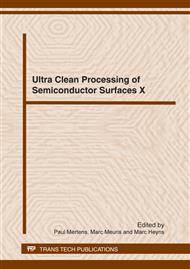p.33
p.37
p.41
p.45
p.49
p.53
p.57
p.63
p.67
Deposition Wet-Etching Deposition (DWD) Method for Polysilicon Gate Fill-In at Flash Memory
Abstract:
The present study aims at polysilicon material fill-in at re-entrant profile at flash memory product. The void was observed after polysilicon fill-in. In order to prevent the void formation, the multi-step process of deposition wet-etching deposition (DWD) method was evaluated. The DWD method is found to play beneficial roles in achieving void-free in the floating gate. The high concentration of NH4OH in APM was choosing for wet etching solution. Scanned electron microscopy (SEM) and transmission electron microscopy (TEM) were employed to measure the polysilicon thickness and cross-section profile of device.
Info:
Periodical:
Pages:
49-52
Citation:
Online since:
April 2012
Authors:
Keywords:
Price:
Сopyright:
© 2012 Trans Tech Publications Ltd. All Rights Reserved
Share:
Citation:


